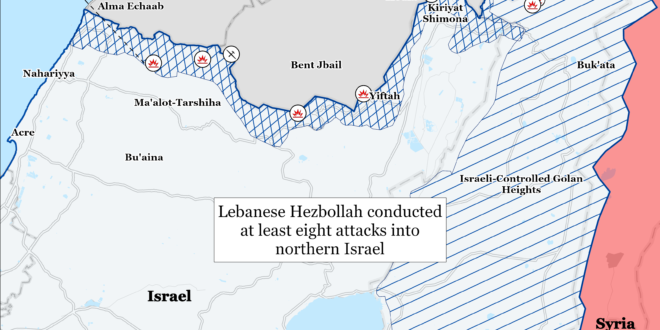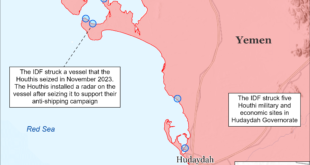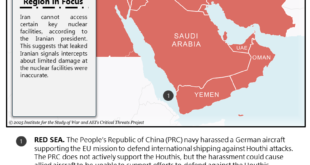Different elements of the Iranian regime have advocated for varying responses to Israel’s killing of Hamas Political Bureau Chairman Ismail Haniyeh in Tehran on July 31. The different messages across the regime are very likely emblematic of differences in opinion between different camps in the regime. The messages may also reflect changes in position within these camps. Senior Iranian military and security officials, as well as Iranian armed forces- and IRGC-affiliated media, have suggested that Iran and its Axis of Resistance seek to conduct a coordinated, large-scale attack on Israel.[i] Iranian Supreme Leader Adviser Ali Shamkhani, for example, claimed on August 10 that Israel “only understands [the] language of force.”[ii] Iranian armed forces-run outlet Defa Press separately published an article on August 10 speculating that Iran could attack Tel Aviv and Haifa.[iii] The publication of this article does not necessarily mean that Iran will target Tel Aviv and Haifa, and more likely reflects the Iranian armed forces’ general desire to strike Israel directly. Other elements of the regime, including moderate President Masoud Pezeshkian, have advocated for attacking “secret Israeli bases” in Iraqi Kurdistan or Azerbaijan to avoid a direct conflict with Israel.[iv] It is not possible to conclusively determine from individual statements exactly how and when Iran will respond to Israel given that these statements intentionally and unintentionally obfuscate regime discussions and Iran’s intent behind a potential attack.
The general trends reflected in Iranian rhetoric, however, support CTP-ISW’s ongoing assessment that Iran and its Axis of Resistance will most likely conduct a coordinated, large-scale attack on Israel. The number of Iranian official statements vowing a “harsh” and “forceful” response to Israel far outweigh the number of statements calling for a more limited response. CTP-ISW’s assessment is also not only based on Iranian rhetorical statements, but also on CTP-ISW’s prior assessments about Iranian objectives and perceived strategic requirements. CTP-ISW previously assessed that Iran likely seeks to restore deterrence after its unsuccessful April 2024 attack while simultaneously trying to avoid a large-scale war with Israel.[v] Iran and its allies fired around 170 one-way attack drones, 30 cruise missiles, and 120 ballistic missiles at Israel in the April 2024 attack.[vi] The United States, Israel, and their allies intercepted most of the projectiles, and the Iranian attack did significantly less damage than Tehran intended.[vii] CTP-ISW previously assessed that Iran could modify its April 2024 attack model in several ways, including by increasing the volume of projectiles it fires at Israel or changing the number of locations in Israel that it targets, to increase the likelihood of inflicting serious damage on Israel.[viii] CTP-ISW will continue to track and report the general trends in Iranian rhetoric across different elements of the regime while highlighting which elements of the regime likely have the most influence.
Unspecified Iranian-backed Iraqi fighters conducted a drone attack targeting US forces at the Rumalyn Landing Zone in Hasakah Province, Syria, on August 9.[ix] An unspecified US official told Reuters that the attack does not appear to have caused injuries but that medical evaluations are ongoing.[x] Iranian-backed Iraqi militias have claimed six attacks targeting US forces in Iraq and Syria since late mid-July 2024.[xi] CTP-ISW assessed on July 17 that Iranian-backed Iraqi militias appear to have resumed their attack campaign targeting US forces in the Middle East.[xii]
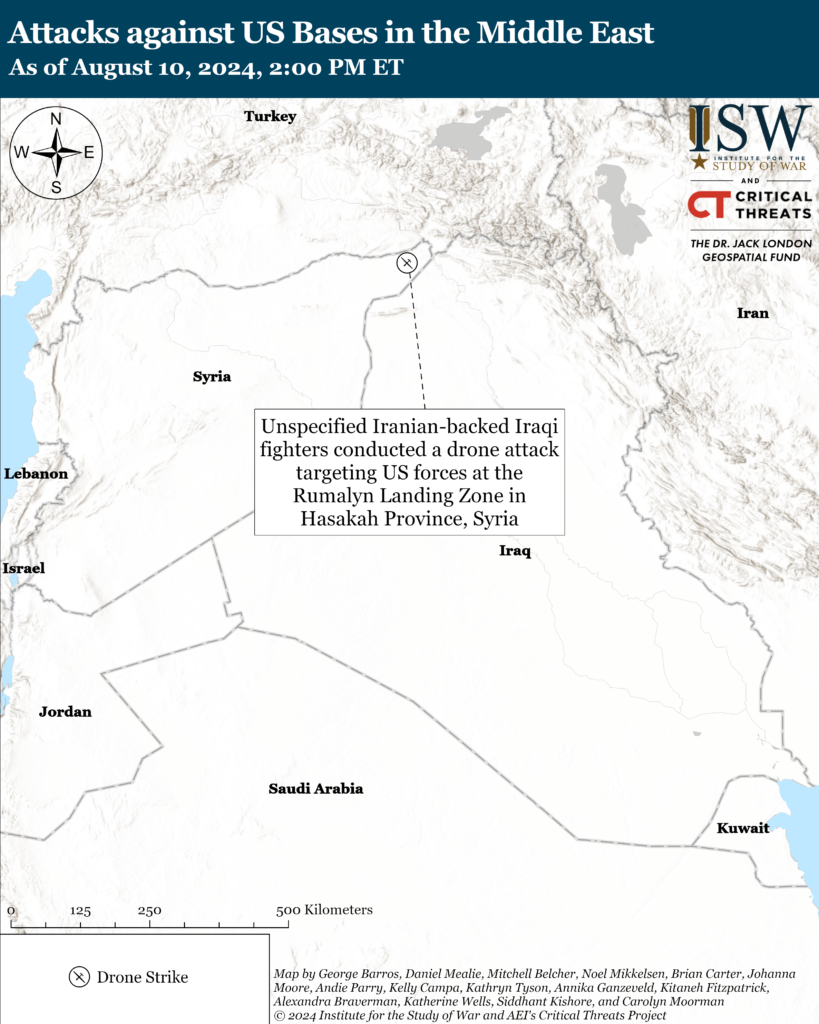
Key Takeaways:
- Iranian Retaliation: Different elements of the Iranian regime have advocated for varying responses to Israel’s killing of Hamas Political Bureau Chairman Ismail Haniyeh in Tehran on July 31. The general trends reflected in Iranian rhetoric, however, support CTP-ISW’s ongoing assessment that Iran and its Axis of Resistance will most likely conduct a coordinated, large-scale attack on Israel. The different messages across the regime are very likely emblematic of differences in opinion between different camps in the regime. The messages may also reflect changes in position within these camps. It is not possible to conclusively determine from individual statements exactly how and when Iran will respond to Israel given that these statements intentionally and unintentionally obfuscate regime discussions and Iran’s intent behind a potential attack.
- Iraq and Syria: Unspecified Iranian-backed Iraqi fighters conducted a drone attack targeting US forces at the Rumalyn Landing Zone in Hasakah Province, Syria, on August 9.
- Gaza Strip: The IDF Air Force targeted a group of Hamas fighters in a mosque at the al Tabaeen school in al Daraj, Gaza City on August 10.
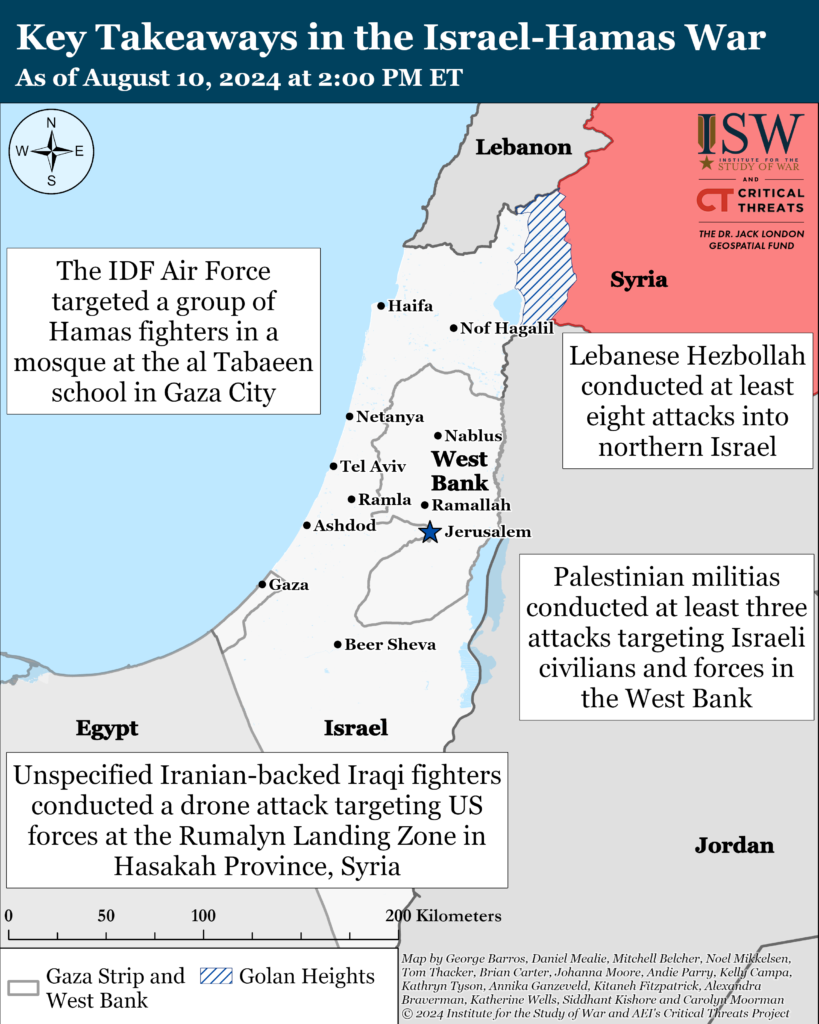
Gaza Strip
Axis of Resistance objectives:
Erode the will of the Israeli political establishment and public to sustain clearing operations in the Gaza Strip
Reestablish Hamas as the governing authority in the Gaza Strip
The IDF Air Force targeted a group of Hamas fighters in a mosque at the al Tabaeen school in al Daraj, Gaza City on August 10.[xiii] The IDF reported that Hamas used the school to hide fighters and plan attacks on Israeli forces and Israeli civilians. An Israeli Army Radio correspondent reported that the IDF used four GBU-39 small diameter precision-guided glide bombs to target the fighters, who were located on the men’s level of the multi-level mosque. The correspondent said that the IDF Air Force used this specific bomb to prevent damage to other floors to reduce civilian casualties.[xiv] The IDF reported that a school close to the mosque was being used to shelter displaced Gazans.[xv] The Israeli Air Force reportedly killed 20 Hamas fighters who participated in Hamas’ attack on October 7, including a Hamas company commander and ”departmental commander.”[xvi] The Israeli Army Radio correspondent reported that the IDF’s intelligence showed no civilians present in the room.[xvii] Local Palestinian reports and the Gazan emergency services reported that the strike during morning prayer killed at least 54 people, including women and children, and wounded ”dozens.”[xviii]
The IDF reported on August 10 that the Israeli Air Force killed the head of Hamas’ General Security for the southern Gaza Strip Walid Alsousi.[xix] Alsousi supported Hamas’ intelligence production and developed sources.
The Popular Resistance Committees and the Martyr Abdul Qader al Husseini Brigades—a splinter group of the al Aqsa Martyrs’ Brigades—mortared an Israeli command site along the Netzarim Corridor on August 10.[xx]
The 98th Division has continued clearing operations in Khan Younis since CTP-ISW’s last data cut off on August 9.[xxi] The 98th Division launched its fourth clearing operation into Khan Younis on August 9.[xxii] The 7th and 35th Paratroopers brigades conducted targeted raids on militia targets, destroyed militia infrastructure, and killed Palestinian fighters.[xxiii] Hamas fighters launched a salvo of rockets targeting Israeli forces east of Khan Younis.[xxiv]
The 162nd Division has located militia weapons caches and killed fighters during clearing operations in Rafah since CTP-ISW’s last data cut off on August 9. Israeli forces directed an airstrike on Palestinian fighters operating near the 162nd Division. The 215th Artillery Brigade (162nd Division) targeted Palestinian fighters over the past week who participated in the Shevah massacre on October 7.[xxvi] The al Aqsa Martyrs’ Brigades—the self-proclaimed militant wing of Fatah—mortared Israeli forces near Yabna camp south of Rafah city.[xxvii]
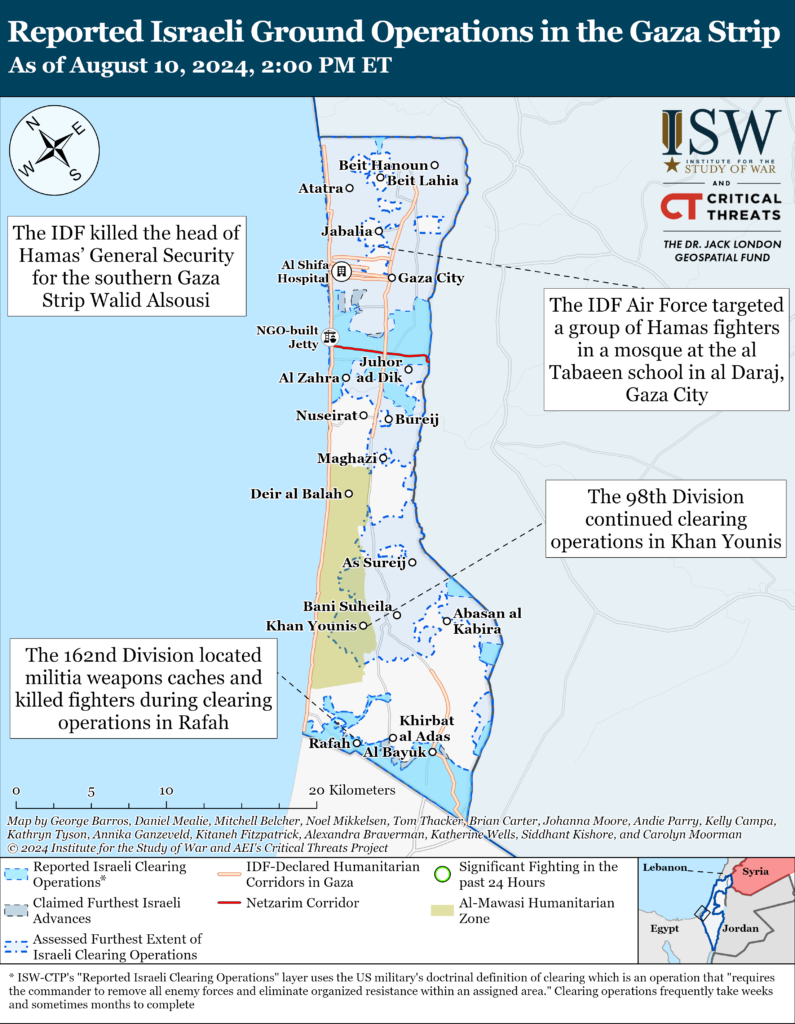
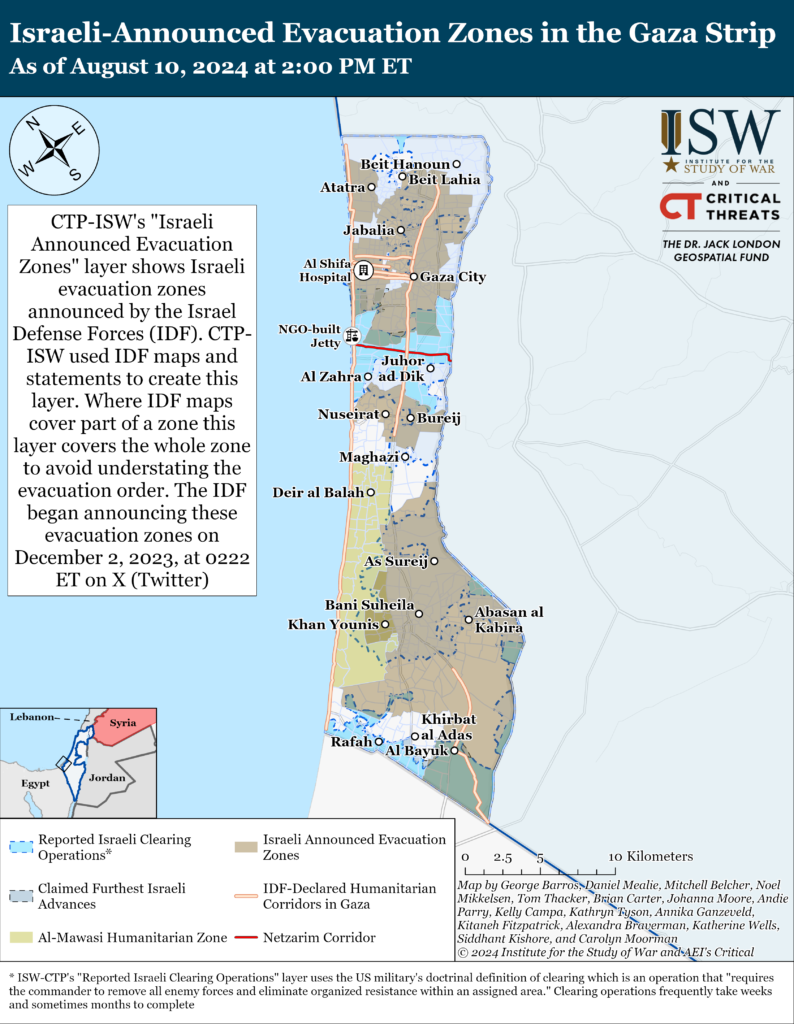
The IDF reported on August 10 that four rockets launched from the Gaza Strip detonated outside of Kissufim, southern Israel.[xxviii]
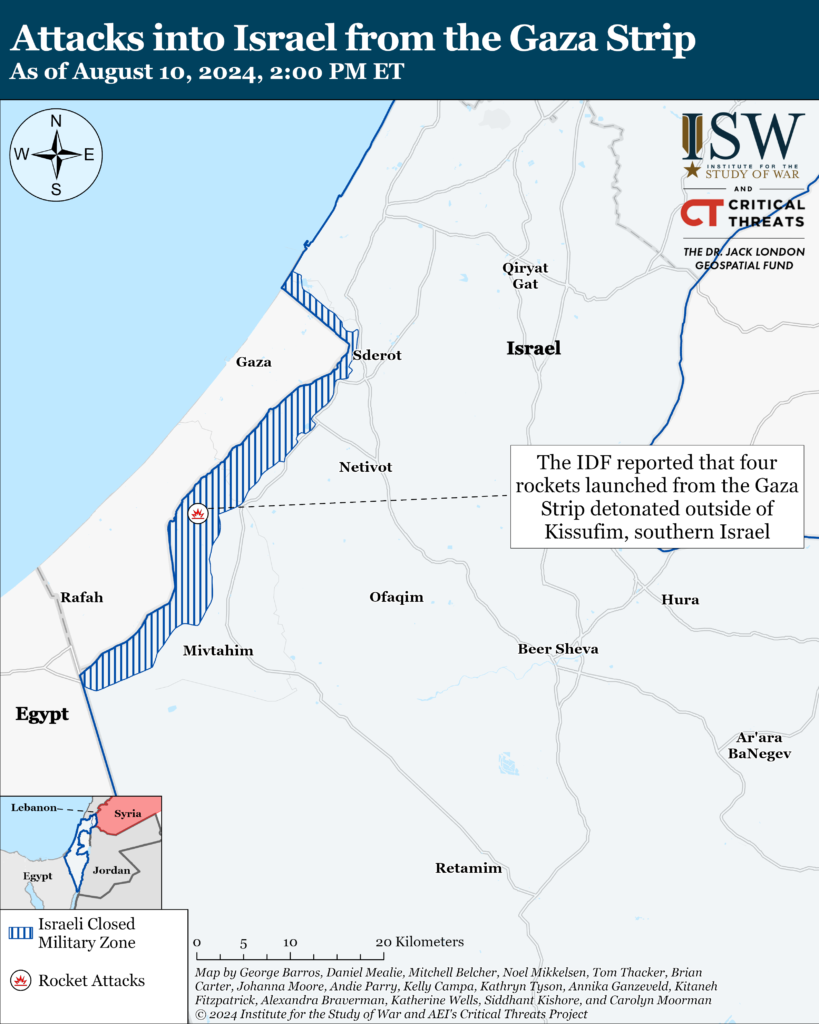
Recorded reports of attacks; CTP-ISW cannot independently verify impact.
add note
tweet
West Bank
Axis of Resistance objectives:
Establish the West Bank as a viable front against Israel
Palestinian militias conducted at least three attacks targeting Israeli civilians and forces in the West Bank since CTP-ISW’s last data cutoff on August 9.[xxix] The al Aqsa Martyrs’ Brigades fired small arms targeting Avnei Hefetz settlement, south of Tulkarm, on August 9.[xxx] The al Aqsa Martyrs’ Brigades separately fired small arms and detonated improvised explosive devices (IEDs) targeting Israeli forces in Tulkarm refugee camp and Balata refugee camp on August 9.[xxxi]
Palestinian militia groups including Hamas and Palestinian Islamic Jihad (PIJ) called upon Palestinians to demonstrate across the West Bank against recent Israeli airstrikes in Gaza on August 10.[xxxii]
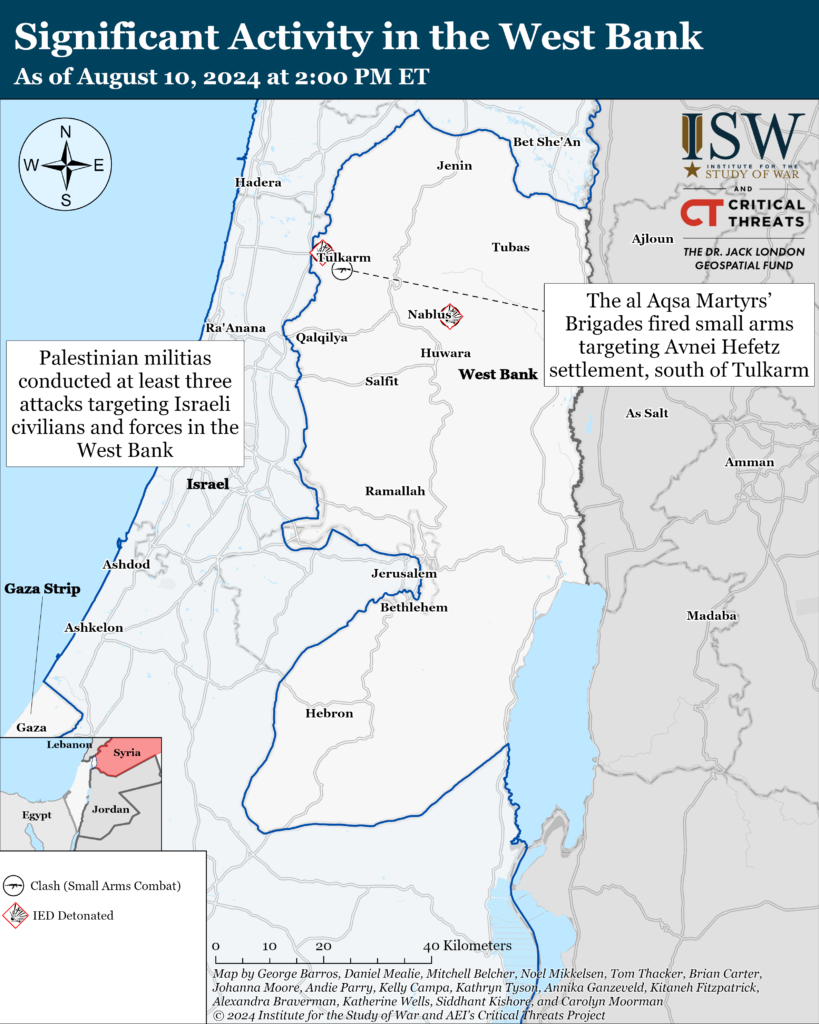
This map is not an exhaustive depiction of clashes and demonstrations in the West Bank.
add note
tweet
Southern Lebanon and Golan Heights
Axis of Resistance objectives:
Deter Israel from conducting a ground operation into Lebanon
Prepare for an expanded and protracted conflict with Israel in the near term
Expel the United States from Syria
Lebanese Hezbollah conducted at least eight attacks into northern Israel since CTP-ISW’s last data cut-off on August 9.[xxxiii] Lebanese Hezbollah claimed that it fired a barrage of Katyusha rockets targeting Eilon, Israel, on August 10.[xxxiv] Hezbollah claimed that the attack on Eilon was in retaliation for recent Israeli airstrikes targeting Tayr Harfa and Ayta ash Shaab in southern Lebanon.[xxxv] The IDF reported on August 9 that it stuck Hezbollah Infrastructure in Ayta ash Shaab because Hezbollah fighters used the Ayta ash Shaab site to launch attacks targeting the Upper Galilee.[xxxvi]
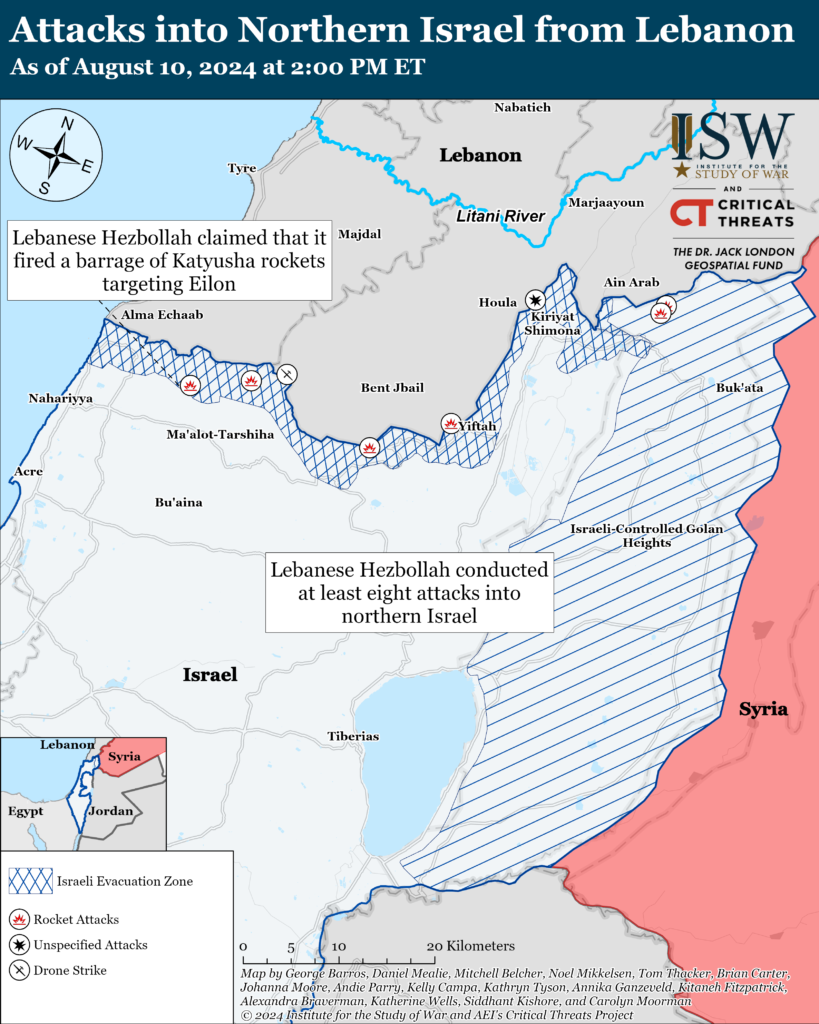
Iran and the Axis of Resistance
US Central Command (CENTCOM) destroyed one missile launcher and one uncrewed surface vessel in Houthi-controlled areas of Yemen on August 9.[xxxvii] CENTCOM also destroyed two Houthi drones over the Red Sea.[xxxviii] CENTCOM determined that these weapons presented an imminent threat to US and coalition forces, as well as merchant vessels in the region.
 Eurasia Press & News
Eurasia Press & News
